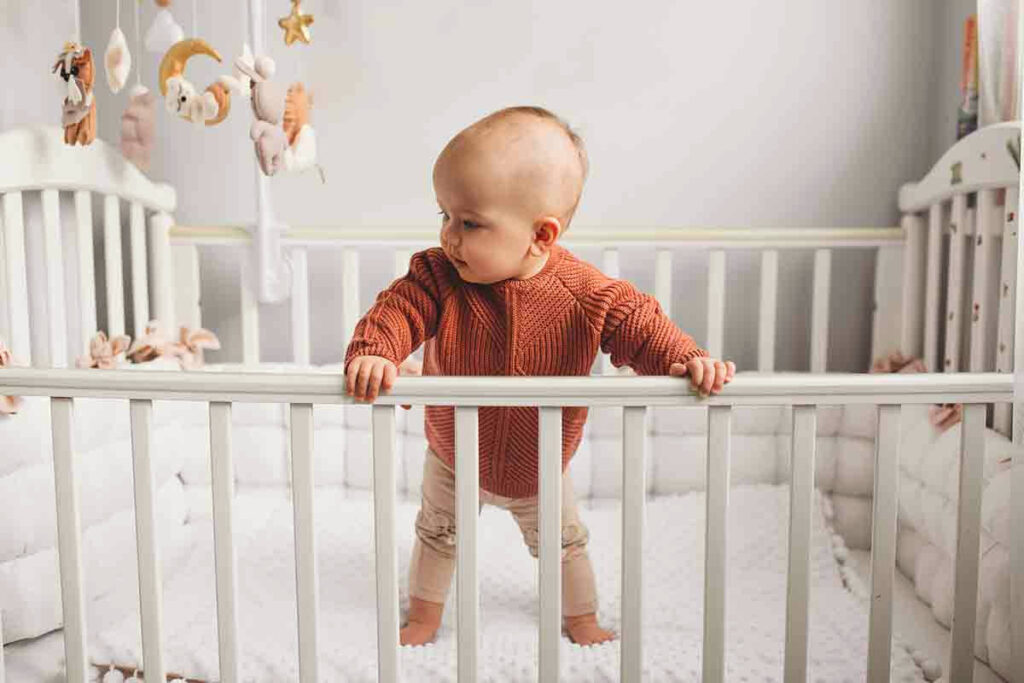How to get a baby to sleep in a crib? Do you need help getting your baby to enjoy sleeping in their crib? It can be a tricky process, but with the right tips and techniques, it is possible for your little one to settle down comfortably at night. From swaying back and forth to providing soothing sounds, there are many methods that can lead to peaceful nights of snoozing!

Getting your baby to snooze soundly in the crib can be a challenge. Fortunately, we have seven effective tips to make it easier! Discover how you and your little one can get some restful sleep tonight with this helpful advice.
Benefits of Getting Baby to Sleep in Crib
Cribs provide a multitude of advantages when it comes to your baby’s sleep. Opting for one can greatly reduce the chance of sudden infant death syndrome, as well as create healthy sleeping habits that will help them stay peaceful into adulthood. Cleanup is a snap compared to beds thanks to fitted sheets and mattresses keeping everything neat and cozy!
How to get a baby to sleep in a crib?
Setting a calming atmosphere for your baby is essential to helping them drift into dreamland in their crib. To create this peaceful environment, ensure the room is quiet and dark. Keep it clutter-free by removing toys from the area and make sure that bedtime rituals are followed – having established routines will assist with sleep cues! Here’s some advice you can follow; seven strategies to help your little one get used to snoozing in a cot.
Tip #1 – Establish a Bedtime Routine
Steps for Establishing a Bedtime Routine For your Baby
Establishing a pre-bedtime routine is key to helping your little one drift off and stay asleep soundly. Try winding down with some quiet activities like reading, singing lullabies, or playing simple games – anything that lets them rest without getting too excited! Make sure their sleep space has all they need; blankets, stuffed animals, and even a pacifier if needed can help bring comfort before bed. Lastly, remember not to expose them to any overstimulating media such as TV or computers which could disrupt bedtime altogether.
Steps for Making Sure Baby is Ready for Sleep
Get your little one ready for a restful night with this helpful guide to prepping them for sleep. From establishing regular bedtimes and naptimes to creating comforting routines, you’ll have all the tips necessary to ensure sweet dreams!
- Establishing a consistent bedtime routine can be key to creating healthy sleep habits for your baby. Setting regular sleep and wake times helps create an optimal schedule that ensures good restorative quality at night so they feel ready each day!
- By keeping a calm environment for your little one, you can help ensure they get the restful sleep that their growing bodies need. Try to avoid activities such as playing music or talking once your baby has settled in for bedtime – this will aid them on a tranquil journey into dreamland!
- Sleeping comfortably is key to helping your baby get the rest they need. Keep their room at a temperature that isn’t too hot or cold, and dress them in clothing made of light fabrics like cotton! Ensuring good sleep conditions can help ensure better quality shut-eye for wee ones.
Tip #2 – Use a Pacifier
Why a Pacifier is Beneficial
Pacifiers are a sleep-inducing asset to parents of babies! Without it, little ones often don’t get enough restful slumber. Research proves that when given the choice between two differently sized pacifiers – large or small – infants tend to select one size most often and hold onto it while sleeping longer throughout the night. Plus, just having something familiar in their mouth helps soothe them even if they aren’t necessarily hungry or thirsty.
How to Introduce a Pacifier to your baby
Introducing a pacifier to your baby can be an important part of soothing and comforting, but there are some considerations before you make the decision. Be sure to weigh all the factors carefully!
- Looking for the perfect pacifier to keep your little one soothed and content? With a wide range of choices on the market, there is sure to be an option that’s just right. Selecting the ideal pick means making sure it has all the necessary components in a place like comfort levels for sucking – plus ensuring the baby doesn’t develop any overuse habits!
- Want to introduce a new pacifier? Go slow! It’s not unusual for babies to reject unfamiliar objects, so instead of diving right in with their first taste of the binky – take your time. Gradually increase exposure bit by bit until your baby is happily making use (or even addicted) to its comforting effects.
- Sleep is essential for your little one’s health and development, especially if they’re using a pacifier. Without ample rest -and quality nutrition- their reliance on the soother could become problematic when it comes time to wean them off!
Tip #3 – Swaddle Your Baby
Benefits of Swaddling
Swaddling is a great way to provide comfort and security for your little one! Benefits include reducing the risk of SIDS, calming crying babies, minimizing colic symptoms, and promoting healthy sleep habits. All around it’s an excellent choice to keep the baby feeling snug as a bug in their swaddle blanket while giving you peace of mind.
How to Swaddle your baby
Swaddling can be a great way to keep your baby feeling secure and comfortable. To successfully swaddle them, make sure the blanket is snug around their body but not so tight that it restricts movement; alternatively, you may want to try using a specialized swaddle wrap instead!
Tip #4 – Set the Mood
Using White Noise
Create a peaceful sleep environment for your baby by utilizing the power of white noise. This type of sound has been scientifically proven to be soothing, thereby improving sleeping conditions and setting up an atmosphere conducive to restful slumber. Give calming rain, ocean waves, or even a fan whirr a try; you just never know which one may work best!
Maintaining a Cool Room Temperature
Your baby’s sleep is essential for their health and well-being, so it’s important to keep the room temperature just right. Ideal sleeping conditions are around 74 degrees Fahrenheit – sweltering temperatures may cause your baby to sweat profusely and excessively cold ones can make them shiver!
Tip #5 – Place Your Baby in the Crib Awake
Why Place Baby in Crib Awake
Placing a baby in their crib awake can be beneficial for both parents and babies. It is thought that having an active, alert infant during the early stages of development helps foster healthy habits and developmental milestones. Additionally, it can help provide comfort to the little ones by allowing them to move around freely within their sleeping environment.
Tip #6 – Respond to Baby’s Cries
How to Respond to Baby’s Cries
If your little one wakes up and starts to cry in the night, don’t hesitate – to take action! Quickly comfort them and help put them back to sleep. If they are still struggling, try these helpful tips for getting baby snoozing soundly once more.
Effects of Not Responding to Baby’s Cries
Babies rely on crying to express their needs – but sadly, if these cries are left unanswered they may suffer. Unresponded-to-infant distress can lead to issues such as fatigue and aggression down the line, potentially even impacting mental health in adulthood. If you’re not sure how best to respond when your baby starts wailing, it’s a good idea to chat with your doctor or healthcare provider for support.
Tip #7 – Pay Attention to Hunger Cues
Recognizing Hunger Cues
When your baby is trying to communicate his hunger, he may give you certain clues such as fussiness, increased crying, or decreased activity. These cues are an important indication that it’s time for mealtime! It might also explain why they wake up shortly after being placed in the crib – little tummies need feeding and resting between meals!
Feeding and Napping Schedule of your baby
As your baby grows, so too does their schedule! Up until the age of 6 months, most babies will typically wake up in time for a morning feeding before taking a nap around lunchtime. This rest period usually lasts about an hour and helps to fuel them for further exploration throughout the day.
Helpful Products
Has your baby been giving you a tough time settling to sleep? It may be worth exploring some of the helpful products available that can make it easier. From soothing lullabies and white noise to light sleeper pillows and pacifiers — there are options for finding something that works best for both parent and child!
WelsLife Breathable Organic Cotton Bassinet Bedding Set
- In the summertime, enjoy enhanced breathability with 3D-air mesh construction – designed to keep you cool and comfortable. For cozy winter warmth, this same technology creates an insulated environment that will have your head in the clouds!
- Its ergonomically designed back is crafted from Global certified 100% Organic Cotton and enhanced with an innovative 3D Cool Air mesh for maximum breathability. Enjoy hours of comfort in any workspace!
- The middle of this device is designed with a gentle curve to provide the optimal height, keeping you comfortable even on bumpy roads.
Conclusion
Helping your baby settle in their crib can be a wonderful, bonding experience! With an intentional sleep routine and calming environment, you’re setting them up to reach this crucial milestone. As they become conditioned to associate the familiarity of these practices with sleeping peacefully through the night. Remember to avoid overstimulation and keep their environment as quiet and dark as possible.
Finally, try not to pick babies up every time they cry and instead use gentle rocking or shushing to help them drift off. With these seven tips, you’ll be on your way to helping your baby sleep peacefully in their crib. You can visit our blog section for more tips.
Reading suggestions:


